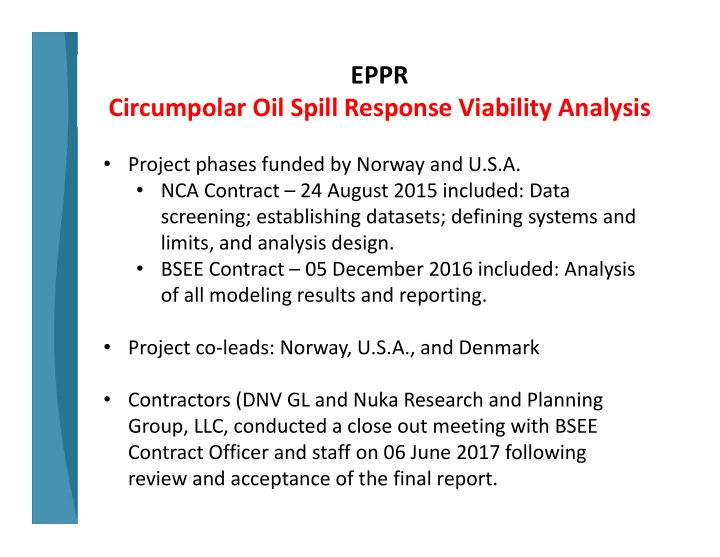

EPPR Circumpolar Oil Spill Response Viability Analysis • Project phases funded by Norway and U.S.A. • NCA Contract – 24 August 2015 included: Data screening; establishing datasets; defining systems and limits, and analysis design. • BSEE Contract – 05 December 2016 included: Analysis of all modeling results and reporting. • Project co‐leads: Norway, U.S.A., and Denmark • Contractors (DNV GL and Nuka Research and Planning Group, LLC, conducted a close out meeting with BSEE Contract Officer and staff on 06 June 2017 following review and acceptance of the final report.
Effects of Arctic Metocean Conditions on Oil Spill Response Wind Sea state Effects on operational Sea ice platforms Air temperature Wind chill Structural icing Light conditions Effects on responders Horizontal visibility Vertical visibility Photo: Norwegian Coastal Administration Effects on response systems 2
Average Results – Whole Area/Year • Conditions were “not favourable” > 50 % of time for all response systems when averaged across the entire study area and entire year • Conditions favourable at least 10 % of the time for the following systems: – Dispersant – Vessel Application (17 %) – Dispersant – Helicopter Application (16 %) – Mechanical Recovery – Two Vessels with Boom (13 %), and – Dispersant – Fixed‐wing Application (12 %) 3
Mechanical recovery, Two Vessels with Boom – Geographical Variability 4
Analysis Key Findings • Arctic conditions are found likely to challenge marine oil spill response operations within the study area. • The response viability varies considerably with system applied, season, and location. • Optimization of response strategies and response systems to the local conditions can have a significant importance for the ability to deploy a response (several other factors should also be considered). • The data created in the study allows for in‐depth studies to identify operational windows for different systems, or identify the system or systems that are most likely to be viable for a particular location. 5
Way forward • The data compiled and technique applied in this study could be used or expanded to explore the impact of different limits based on system modifications, technological innovations, or new documentation of the operational limits for a particular system • Subsequent analyses could also explore changes to response viability as the Arctic environment changes, or inform technological development. Options for extending the response window by combining response systems could be explored 6
Some Lessons Learned (from DNV GL/NUKA Project Team Viewpoint) • Scoping Workshop and subsequent iterations with the “Expert Group”: Worked well and was key to getting all parties “on the same page”. • Data Screening: Very useful, but in the end few alternatives fitted the criteria well. • Preparation of Dataset: Some unforeseen challenges (as expected), but manageable in the end. • Definition of Systems and Limits: Good process, but still shortcomings in proofing/documentation of limits. • Design of Analysis: New and complementary approach with both map‐based and single point assessments. • Dialog with and follow‐up from co‐leads was very constructive and valuable throughout the project. • Effective and very helpful assistance from BSEE, NCA, and EPPR Secretariat throughout the project. 7
Recommend
More recommend